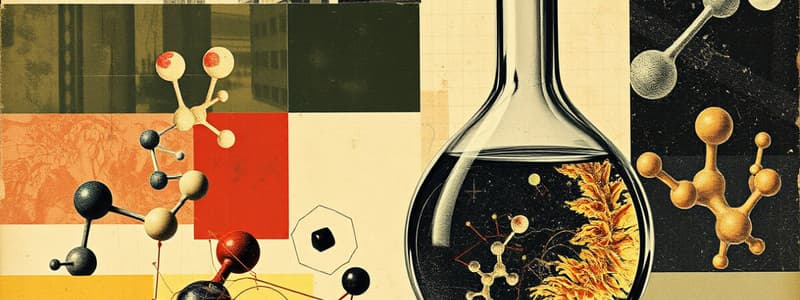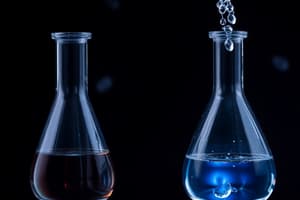Podcast
Questions and Answers
Atoms are the smallest units of matter with their own ______ characteristics.
Atoms are the smallest units of matter with their own ______ characteristics.
chemical
Atoms are divided into 2 basic regions: the central nucleus and the ______ cloud.
Atoms are divided into 2 basic regions: the central nucleus and the ______ cloud.
electron
Protons have a ______ charge and are located in the central nucleus.
Protons have a ______ charge and are located in the central nucleus.
positive
Neutrons are ______ charged particles found in the central nucleus.
Neutrons are ______ charged particles found in the central nucleus.
The number of protons in an atom defines its atomic ______.
The number of protons in an atom defines its atomic ______.
Electrons are ______ charged and have a very small mass.
Electrons are ______ charged and have a very small mass.
The central nucleus of an atom contains both protons and ______.
The central nucleus of an atom contains both protons and ______.
All basic physiological processes of life take place at the ______ level.
All basic physiological processes of life take place at the ______ level.
Electrons contain a ______ charge.
Electrons contain a ______ charge.
An element's mass number is found by adding protons and ______ together.
An element's mass number is found by adding protons and ______ together.
Atoms with an unequal number of protons and electrons are called ______.
Atoms with an unequal number of protons and electrons are called ______.
The rate at which radiation decreases for a specific isotope is known as its ______.
The rate at which radiation decreases for a specific isotope is known as its ______.
Electrons orbit around the nucleus in patterns called ______.
Electrons orbit around the nucleus in patterns called ______.
The outermost energy level of an atom determines its ______ properties.
The outermost energy level of an atom determines its ______ properties.
Each energy level can hold a specific number of ______.
Each energy level can hold a specific number of ______.
A mole is defined as the quantity of an element with a weight in grams equal to its atomic ______.
A mole is defined as the quantity of an element with a weight in grams equal to its atomic ______.
A double covalent bond shares ______ electron pairs.
A double covalent bond shares ______ electron pairs.
Molecules that share electrons equally are known as ______ covalent bonds.
Molecules that share electrons equally are known as ______ covalent bonds.
Water (H2O) is an example of a ______ molecule due to its uneven electron sharing.
Water (H2O) is an example of a ______ molecule due to its uneven electron sharing.
Hydrogen bonds are weak attractions between the positive side of one polar molecule and the ______ side of another.
Hydrogen bonds are weak attractions between the positive side of one polar molecule and the ______ side of another.
Chemical reactions that take place in an organism's cells are called its ______.
Chemical reactions that take place in an organism's cells are called its ______.
The chemical energy in a molecular bond is a form of ______ energy.
The chemical energy in a molecular bond is a form of ______ energy.
Energy cannot be created or destroyed; it can only be changed from one form to another, according to the law of ______.
Energy cannot be created or destroyed; it can only be changed from one form to another, according to the law of ______.
Hydrogen bonds between water molecules contribute to ______ tension.
Hydrogen bonds between water molecules contribute to ______ tension.
Decomposition reactions break larger molecules into smaller ______.
Decomposition reactions break larger molecules into smaller ______.
Hydrolysis is a decomposition reaction that involves adding components of ______ molecules.
Hydrolysis is a decomposition reaction that involves adding components of ______ molecules.
Catabolism is the work done by cells using kinetic energy from ______ reactions.
Catabolism is the work done by cells using kinetic energy from ______ reactions.
Synthesis reactions require ______ to form larger molecules.
Synthesis reactions require ______ to form larger molecules.
Dehydration synthesis removes the water components from the ends of molecular ______.
Dehydration synthesis removes the water components from the ends of molecular ______.
Exchange reactions involve paired decomposition and ______ reactions.
Exchange reactions involve paired decomposition and ______ reactions.
Enzymes reduce the ______ energy needed to get a reaction started.
Enzymes reduce the ______ energy needed to get a reaction started.
Nutrients and metabolites are classified as organic compounds based on carbon and ______ atoms.
Nutrients and metabolites are classified as organic compounds based on carbon and ______ atoms.
Water makes up ______ of our body weight.
Water makes up ______ of our body weight.
Water is called the universal ______ because of its ability to form solutions.
Water is called the universal ______ because of its ability to form solutions.
The ability of water to absorb and retain heat is referred to as high ______ capacity.
The ability of water to absorb and retain heat is referred to as high ______ capacity.
In our bodies, most reactions either involve water or occur in ______.
In our bodies, most reactions either involve water or occur in ______.
Electrolytes are soluble inorganic ions that conduct ______ in solution.
Electrolytes are soluble inorganic ions that conduct ______ in solution.
In water, ionic compounds such as sodium chloride disassociate into ______.
In water, ionic compounds such as sodium chloride disassociate into ______.
Molecules that have polar covalent bonds and dissolve in water are called ______ molecules.
Molecules that have polar covalent bonds and dissolve in water are called ______ molecules.
Water’s ______ nature and hydrogen-bonding capabilities lead to its unique properties.
Water’s ______ nature and hydrogen-bonding capabilities lead to its unique properties.
Flashcards are hidden until you start studying
Study Notes
Objectives of Chemical Organization
- Explain atomic structure and particle types.
- Differentiate how atoms combine into molecules and compounds.
- Identify major types of chemical reactions: decomposition, synthesis, exchange.
- Understand enzyme roles in metabolism.
- Distinguish between organic (containing carbon and hydrogen) and inorganic compounds.
- Define pH and the function of buffers in the body.
- Outline structures and functions of various organic and inorganic compounds.
Atoms, Molecules, and Bonds
- Physical matter comprises atoms which combine to form compounds.
- Atoms consist of a central nucleus (containing protons and neutrons) and an electron cloud (orbiting electrons).
- Protons have a positive charge, neutrons carry no charge, and electrons have a negative charge.
- Atoms are identified as elements, characterized by their atomic number (number of protons).
- An element's mass number is the sum of its protons and neutrons; isotopes differ by neutron count.
- Radioisotopes emit radiation and have a specific half-life defining their decay rate.
- Chemical properties of atoms are influenced by their electrical charge—ions result from unequal proton-electron ratios.
Energy Levels and Chemical Bonds
- Electrons occupy energy levels (shells); Level 1 holds 2 electrons, Levels 2 and 3 hold 8 each.
- Atoms strive to fill their outermost energy level, determining their chemical behaviors.
- Chemical bonds: double covalent bonds share two electron pairs; water is a polar molecule.
- Hydrogen bonds are weak interactions influencing larger molecule shapes like proteins and DNA.
- Water exhibits surface tension due to hydrogen bonding which repels small particles.
Chemical Reactions
- Reactants enter reactions; products are formed from these chemical interactions.
- Metabolism encompasses all reactions occurring within cells and tissues.
- Chemical energy in molecular bonds serves as potential energy, transforming forms during reactions, often releasing heat.
Types of Chemical Reactions
- Decomposition reactions break down larger molecules (e.g., hydrolysis in digestion).
- Synthesis reactions build larger molecules from smaller units (e.g., dehydration synthesis).
- Exchange reactions involve swapping components between reactants.
- Reversible reactions can transition between synthesis and decomposition.
Enzymes and Energy
- Enzymes lower activation energy needed for reactions.
- They act as catalysts, facilitating reactions without being consumed.
Inorganic Compounds
- Organic compounds primarily consist of carbon and hydrogen (e.g., carbohydrates, proteins).
- Inorganic compounds lack carbon-hydrogen frameworks (e.g., water, carbon dioxide).
Water and Its Properties
- Water constitutes 2/3 of body weight and is vital for chemical processes.
- Water solutions are formed by solutes dissolving in the solvent (water).
- High reactivity of water involves hydrolysis and condensation reactions.
- Water's high heat capacity enables temperature regulation.
- Provides lubrication due to low friction between its molecules.
- Water is the universal solvent; ionic compounds dissociate into ions when dissolved.
- Electrolytes (e.g., NaCl) are vital for body functions; imbalances can disrupt physiological processes.
- Hydrophilic (water-loving) organic molecules, like sugar, also dissolve in water.
Studying That Suits You
Use AI to generate personalized quizzes and flashcards to suit your learning preferences.




